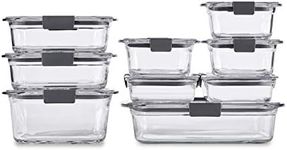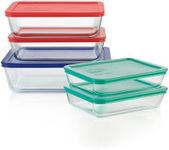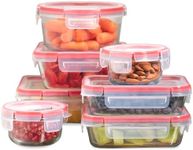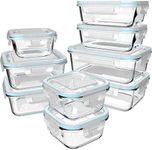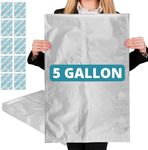Buying Guide for the Best Glass Food Storages
When it comes to choosing glass food storage containers, it's important to consider a few key factors to ensure you get the best product for your needs. Glass containers are a great choice because they are durable, non-toxic, and do not absorb odors or stains. They are also versatile and can be used in the microwave, oven, and dishwasher. To make an informed decision, you should look at the following specifications and understand how they impact the functionality and convenience of the containers.Material QualityThe quality of the glass used in food storage containers is crucial because it affects durability and safety. High-quality borosilicate glass is more resistant to thermal shock, meaning it can handle sudden temperature changes without cracking. This is important if you plan to use the containers in the oven or microwave. Soda-lime glass is another common type, which is less expensive but not as resistant to temperature changes. If you need containers for versatile use, opt for borosilicate glass. For basic storage, soda-lime glass may suffice.
Lid Type and SealThe lid type and seal are important for keeping your food fresh and preventing leaks. Look for lids with airtight seals, such as silicone gaskets, which create a tight closure and prevent air from entering. Snap-lock lids are also popular for their secure fit. If you plan to store liquids or want to keep food fresh for longer periods, an airtight seal is essential. For dry foods or short-term storage, a simple snap-on lid may be adequate.
Size and ShapeGlass food storage containers come in various sizes and shapes, which can affect their usability and storage efficiency. Consider what types of food you will be storing and how much space you have in your refrigerator or pantry. Round containers are great for soups and stews, while rectangular or square containers are more space-efficient and stackable, making them ideal for meal prep and storing leftovers. Choose sizes that match your portion needs; smaller containers for snacks and larger ones for family-sized meals.
StackabilityStackability refers to how well the containers can be stacked on top of each other, which is important for saving space in your kitchen. Containers with flat lids and uniform shapes are easier to stack, helping you maximize storage space. If you have limited storage space, look for containers specifically designed to be stackable. This feature is particularly useful for those who do meal prep and need to store multiple containers in the fridge or pantry.
Microwave, Oven, and Dishwasher SafetyNot all glass food storage containers are safe for use in the microwave, oven, or dishwasher. Check the manufacturer's specifications to ensure the containers can withstand high temperatures and are dishwasher safe for easy cleaning. Borosilicate glass is typically safe for all three, while soda-lime glass may have limitations. If you plan to reheat food directly in the container or want the convenience of dishwasher cleaning, make sure the containers are labeled as safe for these uses.
BPA-FreeBPA (Bisphenol A) is a chemical found in some plastics that can leach into food and beverages, potentially causing health issues. While glass itself is BPA-free, the lids may contain BPA if they are made of plastic. Look for containers with BPA-free lids to ensure your food is stored safely. This is especially important if you are storing food for children or if you are health-conscious. Always check the product labeling to confirm that the lids are BPA-free.
